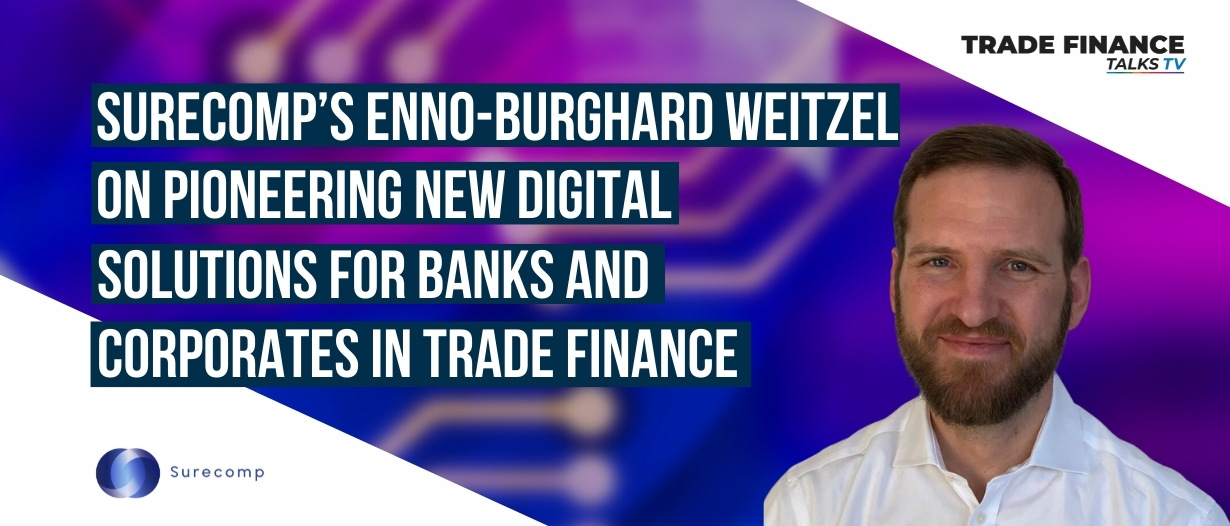After another tumultuous year for trade finance in 2021, the industry is set to face a number of challenges – both old and new – as we head into 2022.
Thanks to new remote working norms introduced by the pandemic, the pace of digitalisation in trade finance has quickened, and calls to reduce paper and streamline processes such as know your customer (KYC) and regulatory compliance have only grown louder.
But unlike in previous years, we enter into 2022 with more than just calls to action.
One software provider that is focused on delivering new digital solutions for trade finance is Canada-based Surecomp.
Enno-Burghard Weitzel arrived at Surecomp in March 2021, after serving for eight years in senior trade finance roles at Germany’s Commerzbank.
Weitzel is now the senior vice president of strategy, digitisation, and business development at Surecomp, tasked with strengthening Surecomp’s position as one of the world’s leading providers of trade finance software solutions.
At present, Surecomp serves around 250 banks with software that automates the processing of trade and supply chain finance.
Additionally, Surecomp supports dozens of multinational corporates to boost the efficiency of their trade finance management processes.
The biggest challenges for banks in trade finance

One of the perks of Weitzel’s new role is that he is able to speak with the heads of trade finance teams at major global banks globally – an opportunity that would have been off-limits while working for Commerzbank.
Based on these conversations, Weitzel said there are five recurring challenges that major banks are grappling with in trade finance.
The first of these is regulation, including topics such as Basel IV, know your customer’s customer (KYCC), and upcoming environmental, social, and governance (ESG) regulations.
The second is margin pressure, whether the result of paper-based processes that lead to errors, high handling costs, and high turnaround times, or the result of competition from non-bank rivals such as insurance brokers who fall outside of Basel IV.
This allows those insurers to offer more attractive terms to banks and corporates, thus creating an uneven playing field.
The third biggest pain point is fraud, which Weitzel refers to as the “number one economic challenge” for banks in trade finance.
Not only a strain on margins, fraud can also pose an existential threat to a bank’s entire trade finance business, as Dutch bank ABN-AMRO discovered in 2020.
The fourth biggest challenge for banks, as ranked by Weitzel, is adapting to digitalisation.
“We have a scattered environment with digital islands, multiple access channels, and different processes that banks have to manage,” he said.
“And there’s no proposition that has yet gained the traction to evolve as the next new platform that everyone needs to join.
“We also lack standards in the industry from international bodies, and no matter which bodies they are, there’s no API trade finance standard out there yet.”
And finally, meeting new digital-first customer expectations is a major challenge for banks, but it also represents a major opportunity for Surecomp.
Challenges for corporates
In addition to serving major banks, Surecomp also has a growing corporate customer base.
For corporates, as Weitzel explains, their biggest pain point is the time-consuming nature of trade finance processes.
“It just takes ages to get an instrument up and running,” said Weitzel. “I was talking to a midsize energy trader, and they have four people in their trade finance department managing 10 letters of credit per month.
“Another corporate told me they were spending six weeks to get one guarantee applied for and actually issued.
“This is just unbearable, and the banks and institutions are putting these processes on the corporates simply because they have no other choice.”
The second pain point for corporates is the delays, uncertainties, and difficulties that come with managing physical supply chains.
And this feeds into the third pain point: the scattered nature of communications in trade finance.
But the good news, according to Weitzel, is that both these issues can be solved through greater digitalisation and platformisation.
“Every midsize corporate would easily work with three-plus banks and financiers, some with 20- plus institutions,” said Weitzel.
“But they don’t just log in to 20 different portals of the banks: they simply do not.
“I was talking to one commodity trader, a global active one, and he was sending back and forth communications via email, deliberately choosing a relatively insecure channel of communication because not all of his banks would offer multi-banking standard communications, and he simply refused to log into those bank-model corporates.
“So the trade finance industry is not offering appropriate solutions to these corporates, and we as partners to the industry need to come up with relevant solutions to these problems.”

Regulatory landscape – ISO 20022, MLETR, ESG
In terms of regulatory changes, Surecomp is preparing to deliver solutions for measures such as ISO 20022, ESG, and the Model Law on Electronic Transferable Records (MLETR).
Weitzel said that more and more of Surecomp’s clients have been asking for its systems to be updated to ISO 20022, which is something that Surecomp can deliver.
He also added that the nature of the update will produce more structured data that Surecomp can then leverage for other applications, such as tracking solutions.
“Take the ESG example. With ESG, we want to come up with tracking information on every single transaction: so who is the supplier, who is the buyer, what is the good, and what is the shipping?”, said Weitzel.
“And who is going to process all these data points? Who is going to bring them together? And how are we going to consume them?
“It is clear that we need to continue upgrading the level of data and detail that we are going to provide, so there will be new adoption needs in the industry.
“So the question is not when are we there, but rather how can we reduce the cost of adjustment?”
Answering such questions will provide a trial run for the next big adjustment, MLETR, which Weitzel believes is “just around the corner”.
“MLETR will hopefully enable us to get rid of paper,” he said.
“The UK is pressing ahead – there’s a lot of energy and movement over there – and hopefully Germany and Italy will come, and hopefully the G7 and eventually the G20 will follow.
“All participants will then need to be able to consume and manage, update and amend MLETR.
“So with real digital documents, there will be endless adjustment.
“And for us, the key question is: how can we enable all the participants to easily, conveniently adjust to a new system to manage these new data points?”
Priorities for 2022
Asked about his priorities for 2022, Wetizel said his talks with clients during his first 10 months have given him some bold ambitions going forward.
“Number one is client focus,” he said. “Since joining Surecomp, I have talked to so many clients – super interesting, super insightful conversations – that will be guiding our thoughts for 2022.
“With the clients we’ve overcome SWIFT Release 21, which was a major blocker in terms of focusing on their customers’ business.
“They want to bring services and solutions to their customers, and I think that will mark 2022 – that banks are again focusing on bringing new features, new functionality to improve the business that they can offer.”
Weitzel said another focus for Surecomp will be on collaboration, which he believes is the key to successful solutions.
“No one out there will solve any of the trade finance problems on their own,” he said.
“At Surecomp we have customers on the corporate side, on the banking side – we serve small, midsize, global leading parties, and that brings a variety of input, a variety of insights, and enables us to bring solutions that build on collaboration and can actually solve problems.”
As an example, Weitzel said that working towards a collaborative solution for paper-based guarantees will be a top priority.

Turning “propositions” into “solutions”
As Weitzel sees it, much of Surecomp’s work will be focused on turning “propositions” into “real solutions” for the pain points described above, by making its existing network more accessible and more efficient for both banks and corporates.
“Technically, we are pushing our solutions to the cloud, with an API application in both communication and integration,” he said.
“But the key thing is that we are technically lowering the barriers to actually use these solutions, and it’s a full-size solution that we’re now offering, so people can simply sign up.”
Weitzel’s aim is to ensure that both banks and corporates feel like they must have a “very strong reason” not to be on Surecomp.
“Economically, we are lowering the subscription fees to be really attractive. So ideally, you would have to ask the question: ‘Why not join? It’s ridiculously attractive’.
“We are pushing new features, and as it’s a SaaS, as it’s cloud, the speed at which features will be added to these solutions is much higher than before.
“We will maintain our existing on-premise solutions, but the focus is on our SaaS solutions, and that is what we think we have to do in order to do our bit to enable both corporates and banks to actually use technology to increase their business.”





























